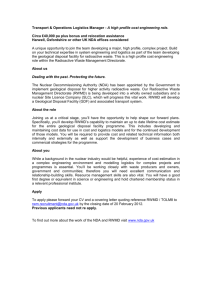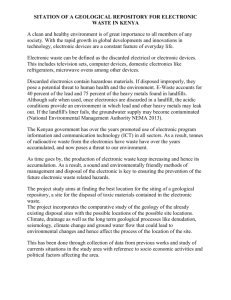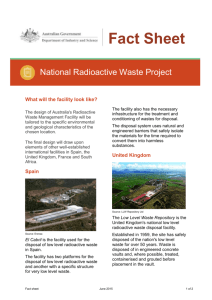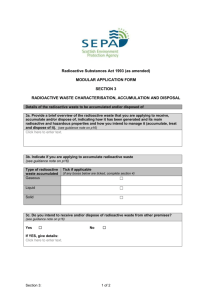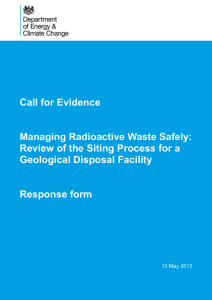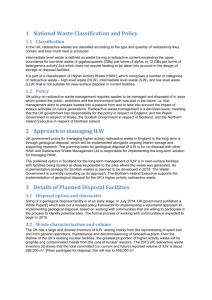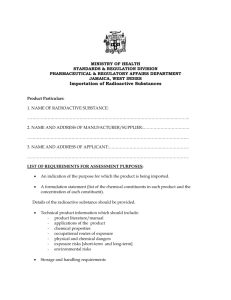MRWS Call for Evidence - Copeland Borough Council
advertisement
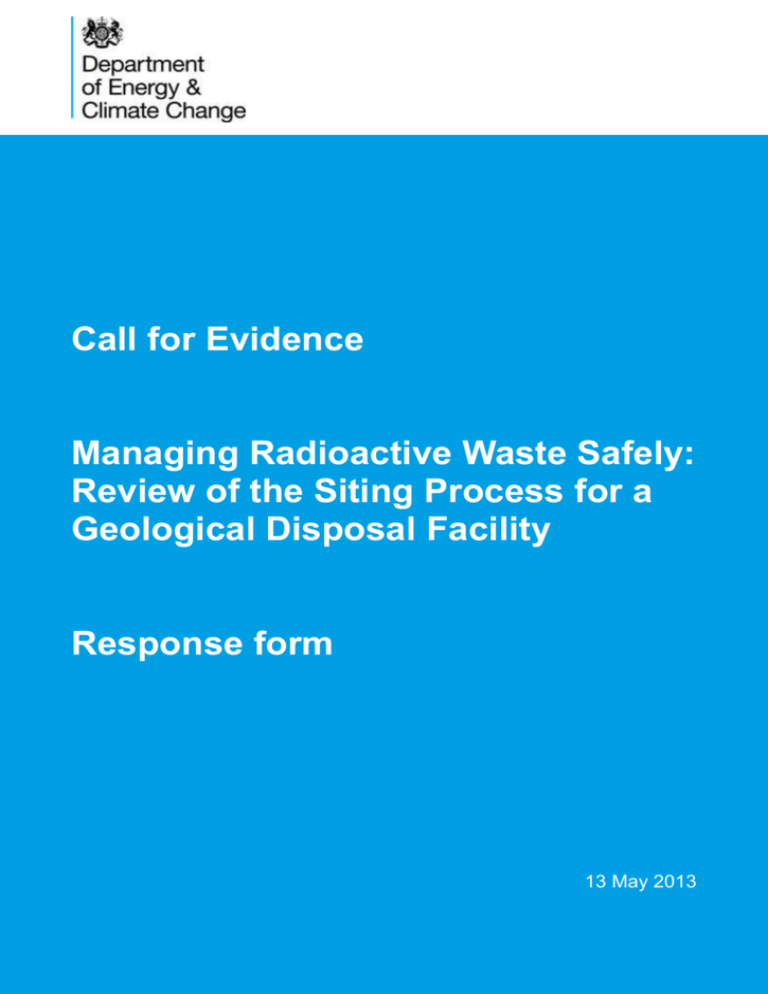
Call for Evidence Managing Radioactive Waste Safely: Review of the Siting Process for a Geological Disposal Facility Response form 13 May 2013 Call for Evidence - Managing Radioactive Waste Safely: Review of the Siting Process for a Geological Disposal Facility Call for Evidence Please use this form to answer questions on the Call for Evidence on Managing Radioactive Waste Safely: Review of the Siting Process for a Geological Disposal Facility. The closing date for the submission of responses is 10 June 2013. Responses can be returned by email (preferable) or post. Email address: radioactivewaste@decc.gsi.gov.uk Or by post to: The Managing Radioactive Waste Safely team Department of Energy and Climate Change 55 Whitehall London SW1A 2EY In order to help us analyse responses, please provide details of your organisation. When the call for evidence ends, we may publish or make public the evidence submitted. Also, members of the public may ask for a copy of responses under freedom of information legislation. If you do not want your response - including your name, contact details and any other personal information – to be publicly available, please say so clearly in writing when you send your response to the call for evidence. Please note, if your computer automatically includes a confidentiality disclaimer, that will not count as a confidentiality request. Please explain why you need to keep details confidential. We will take your reasons into account if someone asks for this information under freedom of information legislation. But, because of the law, we cannot promise that we will always be able to keep those details confidential. The responses to this Call for Evidence will inform a public consultation that will follow in the autumn. We would like to keep stakeholders who are interested in the MRWS process up to date on developments. If you would like to be kept up to date please sign up at the end of the form. 2 Call for Evidence - Managing Radioactive Waste Safely: Review of the Siting Process for a Geological Disposal Facility Introduction 1. The UK Government’s policy for the long-term management of higher-activity radioactive waste is geological disposal1. In 2008 the Managing Radioactive Waste Safely (MRWS) White Paper2 was published which outlined a framework for implementing geological disposal based on the principles of voluntarism and partnership. 2. Three local authorities formally expressed an interest in the MRWS programme: Copeland and Allerdale Borough Councils, and Cumbria County Council. In January 2013, the three local authorities voted on whether to proceed to stage 4 of the process. The two boroughs voted in favour, but the county voted against. The Government had in 2011 given a specific undertaking that the existing site-selection process would only continue in west Cumbria if there was agreement at both borough and county level. The county’s decision therefore ended the existing site selection process in west Cumbria. 3. Shepway District Council in Kent had also taken soundings from local residents, but subsequently decided against making a formal expression of interest in the current MRWS process. 4. The Government remains firmly committed to geological disposal as the right policy for the long-term safe and secure management of higher-activity radioactive waste. The Government also continues to hold the view that the best means of selecting a site for a geological disposal facility (GDF) is an approach based on voluntarism and partnership. 5. Evidence from abroad shows that this approach can work, with similar waste disposal programmes based on these key principles making good progress in countries like Canada, Finland, France and Sweden. 6. The fact that two local authorities in west Cumbria voted in favour of continuing the search for a potential site for a GDF demonstrates that communities recognise the substantial benefits that are associated with hosting such a facility – both in terms of job creation and the wider benefits associated with its development. Purpose of the call for evidence 7. In line with the Secretary of State’s written Ministerial statement of 31 January 20133, Government has been considering what lessons can be learned from the experiences of 1 Radioactive waste disposal is a devolved matter. The Scottish Government has a separate policy and supports long-term interim storage and an on-going programme of research and development. The Welsh Government has reserved its position on geological disposal of radioactive waste while continuing to play an active part in the MRWS process. The Department of the Environment in Northern Ireland supports the MRWS programme. 2 Managing Radioactive Waste Safely: A Framework for Implementing Geological Disposal https://www.gov.uk/government/publications/managing-radioactive-waste-safely-a-framework-for-implementinggeological-disposal 3 See https://www.gov.uk/government/speeches/written-ministerial-statement-by-edward-davey-on-themanagement-of-radioactive-waste 3 Call for Evidence - Managing Radioactive Waste Safely: Review of the Siting Process for a Geological Disposal Facility the MRWS programme in west Cumbria and elsewhere. We are now inviting views on the site selection aspects of the ongoing MRWS programme in this call for evidence, particularly from those who have been engaged in (or have been interested observers of) the MRWS process to date. The responses to this call for evidence will inform a consultation that will follow later in the year. Background 8. Higher-activity radioactive wastes are produced as a result of the generation of electricity in nuclear power stations, from the associated production and processing of the nuclear fuel, from the use of radioactive materials in industry, medicine and research, and from military nuclear programmes. 9. As one of the pioneers of nuclear technology, the UK has accumulated a substantial legacy of higher activity radioactive materials. Some of it has already been processed and placed in safe and secure interim storage on nuclear sites. However, most will only become waste over the next century or so as existing facilities reach the end of their lifetime and are decommissioned and cleaned up safely and securely. 10. These higher-activity wastes can remain radioactive, and thus potentially harmful, for hundreds of thousands of years. Modern, safe and secure interim storage can contain all this material – but this method of storage requires on-going human intervention to monitor the material and to ensure that it does not pose any risk to human or environmental health. While the Government believes that safe and secure interim storage is an effective method of managing waste in the short to medium term, the Government is committed to delivering a permanent disposal solution. 11. In October 2006, following recommendations made by the independent Committee on Radioactive Waste Management, the Government announced its policy of geological disposal, preceded by safe and secure interim storage. The Government subsequently announced that it would pursue a policy of geological disposal with site selection on voluntarism and partnership. This remains Government policy. Geological disposal 12. Geological disposal involves isolating radioactive waste in an engineered facility deep inside a suitable rock formation to ensure that no harmful quantities of radioactivity ever reach the surface environment. It is a multi-barrier approach, based on placing packaged wastes in engineered tunnels at a depth of between 200 and 1000m underground, protected from disruption by man-made or natural events. 13. Geological disposal is internationally recognised as the preferred approach for the longterm management of higher-activity radioactive waste. It provides a long-term, safe solution to radioactive waste management that does not depend on on-going human intervention. 4 Call for Evidence - Managing Radioactive Waste Safely: Review of the Siting Process for a Geological Disposal Facility Response form Please use this form to respond to this call for evidence on Managing Radioactive Waste Safely: Review of the Siting Process for a Geological Disposal Facility. The closing date for the submission of responses is 10 June 2013. Responses can be returned by email (preferable) or post. Email address: radioactivewaste@decc.gsi.gov.uk Or by post to: The Managing Radioactive Waste Safely team Department of Energy and Climate Change Room M07 55 Whitehall London SW1A 2EY Name Steve Smith Organisation / Company Copeland Borough Council Organisation Size (no. of employees) c250 Organisation Type Local authority Job Title Nuclear Projects Manager Department Nuclear, Energy and Planning Address The Copeland Centre Catherine Street Whitehaven CA28 7SJ Email Steve.smith@copeland.gov.uk Telephone 01946 598471 Fax Would you like to be kept informed of developments with the MRWS programme? Yes Would you like your response to be kept confidential? If yes please give a reason No 5 Call for Evidence - Managing Radioactive Waste Safely: Review of the Siting Process for a Geological Disposal Facility The Government is interested in your views on the geological disposal facility site selection process outlined in the 2008 Managing Radioactive Waste Safely (MRWS) White Paper. To assist us you may wish to consider the following issues in your response: What aspects of the site selection process in the MRWS White Paper do you think could be improved and how? What do you think could be done to attract communities into the MRWS site selection process? What information do you think would help communities engage with the MRWS site selection process? Below is the response from Copeland Borough Council to the Government's Call for Evidence Managing Radioactive Waste Safely: Review of the Siting Process for a Geological Disposal Facility. The submission is provided following a 4 stage internal Council review of engaging with the process up to the decision about participation into stage 4 on 30th Jan 2013. The review which provides much of the evidence to support this submission involved a technical review of the site selection process as described within the MRWS White Paper, an assessment of the Council's role and engagement with the West Cumbria MRWS Partnership, a review of the Councils decision making processes leading up to 30th Jan and a workshop to gauge the views of Council Members of the wider community and stakeholder engagement in the process. In addition we would cite the final report of the West Cumbria MRWS Partnership as a key foundation of the evidence which has helped shape our submission and where specifically appropriate we have highlighted opinions and advice contained within the report in our comments below. The final report is a full account of over 3 years work of the partners in West Cumbria taking forward the MRWS process and it contains some valuable advice and opinions that would help shape a new/revised process. Finally as one of only 3 Council's that has direct experience of implementing the MRWS process in Copeland and West Cumbria as described in the White Paper, and as the recognised lead authority in that process, we would conclude that the process is broadly acceptable and, subject to some areas for improvement around issues about bringing the stages together, providing clearer information and decision making, as described below, the process is sufficient to be progressed and re-presented to the wider community. What aspects of the site selection process in the MRWS White Paper do you think could be improved and how? We support the continued focus on a voluntarism approach. We suggest that any new approach should further define the expectations of national Government, local government and local stakeholder partners around voluntarism and partnership working, to reflect the/any implications of the recent introduction of the Localism Act. 6 Call for Evidence - Managing Radioactive Waste Safely: Review of the Siting Process for a Geological Disposal Facility Any new approach needs to have a clearly defined and identified national advocate body (putting across the case for geological disposal over other alternatives) containing independent experts with the resource to do the task and a clearly defined role for Government/DECC/NDA to continually and consistently provide the Government’s policy position. There could also be a local component to this body to ensure that locally raised issues are dealt with locally in the national context through locally based advocates? The lack of such a body in the West Cumbrian MRWS experience led to a ‘vacuum’ in the pause period which provided an opportunity for those individuals and organisations against progressing further in the process to voice their concerns and with a response from Government and the NDA seemingly limited to responding to facts rather than expressing opinions. The new approach should clearly say how the Government intends to deal with planning arrangements for a GDF. In a future consultation you may wish to seek views on the options that are available for dealing with planning matters and the role of Strategic Environmental Assessments (SEA) in the site selection process. Both areas were matters for considerable debate within the work of the WC MRWS Partnership and appeared as areas of uncertainty in the final report. In a new approach the decision making body should be clearly defined as the local district council in a two-tier situation (or unitary authority where appropriate) where the search for a site would be undertaken and where the impact of such a facility will be felt. In the West Cumbrian experience it was clear that individuals living over 50 miles from Copeland had the opportunity to veto local decision making often based on a lack of accurate information and this notably undermined the decision making process. We would also suggest that you test the concept through consultation that the host community at the initial stage of the site selection process should be the local district or unitary authority. We also believe that such a change in approach will reflect and be consistent with the localism agenda described above. Any new approach should allow for the site selection process and any necessary geological studies to be completed (ie stages 4 and 5 combined) before any further decision about participation is taken. The experience of the process to date and the feedback we have had is that we need to have all the information available on potential sites to be able to make a decision about the next stage. We would also suggest that you may wish to seek views through consultation on the role of Decision Making Bodies in the process. At a minimum it is our view that there is a role for a local authority to hold the right of withdrawal on behalf of the local community and any new process may require a local authority to be at the centre of efforts to manage stakeholder engagement in a lead authority or accountable body type role. However it may be more appropriate to explore views through the consultation on the potential for a local referendum once all the necessary information is available as the means for determining the decision to move to the next stage. We would also suggest that combining stages 4 and 5 would reduce the number of decision points, where experience shows that such decisions are confused with a commitment to proceed and would allow for the community to be asked to consider less complex decisions based on a more complete set of information. A new process needs to allow for local partners to impose local site selection criteria at the commencement of the site selection process. This is quite fundamental and is based on both what the WC MRWS Partnership concluded and our own views around the early stages of the site selection process. 7 Call for Evidence - Managing Radioactive Waste Safely: Review of the Siting Process for a Geological Disposal Facility What do you think could be done to attract communities into the MRWS site selection process? There needs to be a clearer definition of how a GDF relates to current energy policy (including nuclear new build) and emphasise the national significance of the project. Outside of the immediate area the significance of the approach had very limited understanding. A new approach needs to clearly say why a GDF is the most appropriate means of dealing with this waste and explain why other alternatives are not suitable and for what reason. Our experience is that the current Government policy on higher level radioactive wastes was continually challenged as the most appropriate way forward and alternatives suggested but were not consistently responded to as to why they were not acceptable. Any new approach needs to clearly articulate the technical role of a GDF, the scope/inventory and ownership of the wastes and the process of radiological decay. Levels of understanding around such matters is clearly limited and a number of 'myths' exist which need to be dispelled. Such analysis should also include the current Government view on retrievability and why it is seen as a significant issue by some. The Government needs to clearly state how it intends to put the right of withdrawal and community benefits on a legal footing and clarify how responsibility for the right of withdrawal (held by local authorities close to the area that has expressed an interest on behalf of the whole community that they represent) meets community expectations around voluntarism. Government may wish to seek views on the options available to Government and local communities including an analysis of the pros and cons of each. Government should consider the right of withdrawal existing up to the point that a planning application (or similar) for the project is approved. This would give communities additional confidence in the process allowing local communities to exercise their right of withdrawal if the design process for the facility identifies significant local concerns. Government should consider international experiences of how it might make available community benefits to an area in advance of a GDF taking place, recognizing the national significance of the project and the perception of impact on an area even in advance of a commitment to take the proposal forward. This accords with the work and advice of the WC MRWS Partnership around impacts and in part reflects the early work which was subsequently abandoned after the 30th Jan decision around brand management. Government should make it clear that the costs of engagement for local partners will be fully reimbursed. In the current climate of local government spending cuts there is no option! And Government should consider a mechanism for making funding available for local partners on a programme basis and not subject to annual assessment and approval. 8 Call for Evidence - Managing Radioactive Waste Safely: Review of the Siting Process for a Geological Disposal Facility The final report of the WC MRWS Partnership provides a useful summary of the uncertainties that are associated with GDF development and Government should consider how such uncertainties might be reduced or removed. Uncertainties include those around the scope of the inventory of wastes earmarked for disposal, potential for phased waste emplacements and phased permissioning, potential for waste retrieval and generic R and D. Research and development is one of the most important uncertainties in the programme and to help generate and maintain confidence in the process Government should consider the means to making the R and D programme more visible and with the opportunity for the programme to be monitored and reviewed by any participating partnership. What information do you think would help communities engage with the MRWS site selection process? The work of the WC MRWS Partnership and the issues covered in their final report is a useful checklist of the sorts of information that any local community would want to know when considering engaging with the site selection process. These would include; why geological disposal? - and the national need for such a facility the scale and impacts of such a facility and associated infrastructure the timescales for development a description of the inventory of wastes and why a GDF is the only option how issues of safety and security will be tackled and managed on an on-going basis including the role of regulators and the significance of geology a clear statement on Government's commitment to voluntarism, the local right of withdrawal and the scope and nature of community benefits Any new approach needs to clearly state how public and stakeholder engagement will be managed at a national and local level and the roles of specific bodies including potential Community Siting Partnerships. Building on the advice contained within the final report of the WC MRWS Partnership we would encourage Government to seek views on the role of a Community Siting Partnership in the siting process to test potential options around both scope/role and timing within the process and the potential for the process to recognise the need for the structure of a CSP or similar body to be determined by the host community working with local partners. We would also suggest that Government test through consultation the views on whether a CSP is actually required and consider that for the site selection process the local district or unitary council is identified as ‘host authority’ to manage the next stages of engaging with local stakeholders and the wider community. 9 Call for Evidence - Managing Radioactive Waste Safely: Review of the Siting Process for a Geological Disposal Facility Any new approach needs to ensure that adequate resource is placed on developing and implementing a communications strategy at both the national and local level and this should include all forms of communication including social media. Feedback from the wider community has suggested that despite the considerable efforts of the WC MRWS Partnership through its public and stakeholder engagement programmes there was limited understanding within local communities. Any future approach needs to recognise this and consider a more extensive programme of stakeholder and community engagement with the appropriate level of funding to carry out the task. 10 Call for Evidence - Managing Radioactive Waste Safely: Review of the Siting Process for a Geological Disposal Facility 11 © Crown copyright 2013 Department of Energy & Climate Change 3 Whitehall Place London SW1A 2AW www.gov.uk/decc URN 13D/105
